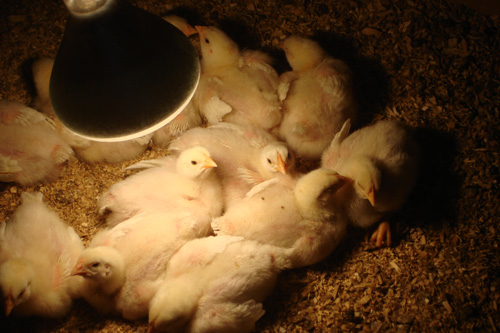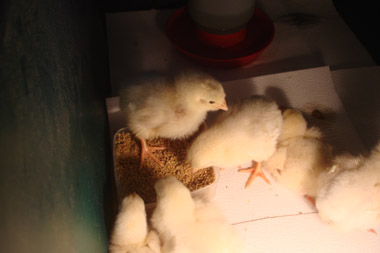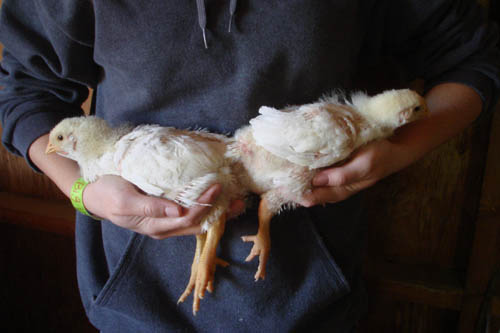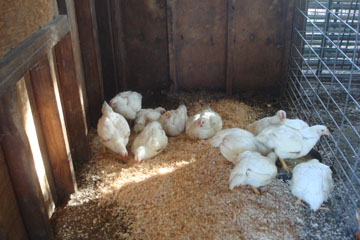Recent comments
Aenean nonummy hendrerit mauris. Phasellus porta.
- jenn on The Best Ever Egg Salad
- Dora Friedli on The Best Ever Egg Salad
- jenn on The Penny Prayer
- jenn on Resurrection
- Dora Friedli on The Penny Prayer
Raising Meat Chickens in Suburbia

From Day Old to Dinner Entrée – If you want to make sure the chicken in your oven is raised well and processed humanely –Raise them yourself!
Most of my friends cringe when I tell them that we raise our own meat chickens and my daughter NEVER tells her friends for fear they will avoid eating over. But, this relatively simple process has become an integral part of our suburban homestead and food storage plan.
I’ve always had laying hens to provide us with eggs for the table and manure for the garden. And, when the girls were too old to lay they got to live out their life scratching around for bugs, churning up the soil and adding manure where ever they went; a mutually beneficial relationship I think.
It wasn’t until my friend Sandy bought and raised her first batch of meat birds that I really started to get interested in raising our own chickens for meat. But, raising 50 chicks seemed a bit too ambitious for a beginner, not to mention someone who lived in suburbia. So, several years ago I began by raising 8 Cornish/White Rock crosses, usually referred to as Cornish Rocks. These fast growing birds are the same breed raised commercially and sold to restaurants and supermarkets either as whole birds or in cut-up parts.
My test project was a huge success! All 8 chicks lived to their 8-week maturity, were healthy and seemingly happy, and the processing of the birds was nothing like I had imagined. When the project was over and we were feasting on own homegrown chicken, juicy and full of flavor I was determined that meat chickens would be an annual crop raised on our little suburban homestead.
Raising meat chickens is a quick and easy way to put quality meat into your freezer. But, because it is such a fast process you must be prepared with facilities, equipment and feed or you’ll have a mess on your hands, and your goal of raising chickens more humanly than commercial operations will be dashed.
Don’t have 8-weeks to dedicate to raising meat birds? You can raise Cornish Game Hens instead. The process, equipment, feed and processing is all the same. The only difference is you raise them for 3- to 4-weeks, from arrival to butchering. This is a great alternative for small families who don’t want a 6- or 7-pound roaster.

Chicks arrive and settle into their brooder.
Facilities
When chicks arrive they’ll need to be put directly into the brooder. A brooder is a small, secure, heated, draft-free container that will keep the chicks safe and warm until they feather out and can be moved to a larger facility. Brooders don’t need to be expensive or fancy. I brood chicks in the garage using an old large lidded plastic storage bin, like the kind used in garage storage. I line the bottom with paper towels or shredded newspaper, put in a shallow container for feed, set the water font in one corner, and clip a heat lamp onto the side so it shines into the middle of the box. Now I’m ready for the chicks to arrive.
When the chick’s feather out at about 3 weeks of age they are moved to a growing coop. Meat birds need about 2 to 3-square feet of floor space to be comfortable. The growing coop can be a separate structure or a repurposed space you already have. I try to get chicks in late August or early September when the lambs have been processed and the barn is free. I have two hog panels that clamp together in an “L” shape and can be set in the far corner of the barn to make a four-sided enclosure. The dirt floor is covered with shavings or straw to help keep the birds warm, clean and dry.
I can’t really say my birds are pasture raised because I don’t have a pasture, but in warmer weather, the birds are allowed to wander the barn and outside areas, scratching and digging for bugs.

Week 3: We’re half way there.
Feed/Water Equipment
Aside from warmth, feed and water is the most important part of raising meat birds, for obvious reasons. Feed containers should be shallow enough for small chicks to reach, but heavy enough so that they can’t tip them over. As chicks grow and need more feed, larger containers can be added. When chicks first arrive I use an 8-inch diameter ceramic dish that’s about 1-inch deep. This allows chicks to eat from all sides and not pile on top of each other getting to the food. As they grow bigger I switch to larger, heavier crocks that hold more feed. When I raise a batch of 25 birds I use an old hopper type feeder that was used for hogs. It easily holds a full bag of feed.
Water can be provided with gallon-sized plastic fonts through the first few weeks of life, but they will need to be refilled a few times each day. When chicks are moved to their growing facility you can continue using the fonts or install an automatic system that will provide a continuous supply of water. Either way, it’s important that the growing chicks have clean water at all times.
Ordering Chicks
Chicks are sold as “day-old” and can either be picked up at the hatchery or shipped to your local post office. Be sure to check the last ship date for the hatchery you use. Some hatcheries have “last day” order dates, which is the last day you can order chicks before they close for the winter.
Cornish/White Rock Crosses are the most common meat chicks available. They are the foundation of the commercial broiler industry. They are bred to grow fast and get to market weight in about 8-weeks. But, with this growth comes a few problems and some controversy about their viability. Their fast growth can cause heart and leg problems that sometimes leads to death. Some consider the breed to be the Frankenstein of the poultry world, with limited use and limited viability within the industry. But, like all livestock, if animals are cared for properly, provided the right kind and amount of feed and water, losses can be minimized. In the years I have been raising meat chickens I have not lost a single one.
Aside from the Cornish Cross, other suitable meat breeds for the suburban homestead include the Red Broiler, Freedom Rangers, Label Rouge, or Corndel, but these will take longer to get to market weight, which means more feed, more water and more of your time.
Feeding
Chickens raised as broilers need a higher percent of protein in their feed than laying hens do. Most commercially mixed broiler feed is between 20 and 22% protein, finishing rations drop down to about 17%.
When chicks first arrive and through their 4th week they should be given a starter mix, which is usually 21 or 22% protein. From weeks 5 to 8 they can be given a developer ration that is about 20% protein, followed by a lower percentage feed from weeks 9 through market if you want larger roasting birds over 6 pounds.
However, if you decide to raise your chicks to Cornish Game Hen size, approximately 2 to 2-1/2 pounds you’ll only need to feed the starter mix. Or, if you decide to process your birds at 8 weeks of age you’ll only feed the starter and developer.
My process of raising meat birds is much less formulated, and in the view of many of my chicken friends a tad comical as well. I feed 3 bags of starter. When I run out I butcher. It’s that simple.

Week 5: In the barn.
Processing Chickens
If you’re raising meat chickens or intend to raise meat chickens, one of the most important skills you’ll want to learn is how to butcher them, or as we like to call it, “dispatching”. It’s a much friendlier word, especially around folks who aren’t use to talking about processing livestock.
Meat chickens were not intended to live long so please don’t try to keep them if you get squeamish about putting them in the freezer. They are bred for rapid weight gain. After a certain weight their legs start to breakdown and as they age they are prone to heart attacks, so they won’t live long like a laying hen or rooster. Keeping them is not saving them, but actually causing them harm and discomfort.
Local resources that might be available to you for advice and training are high school FFA chapters and 4-H clubs. These organizations may be able to point you in the direction of someone you can talk to about processing your birds. Area feed stores may be able to give you the name of local chicken ranches or breeders who may be willing to teach. County Farm Bureau’s or Grange organizations would be other sources to contact.
But, if you’ve decided to try it yourself check out http://butcherachicken.blogspot.com
They have wonderful step-by-step instructions along with great photos of the whole process. They also have detailed instructions on how to build some of your own chicken processing equipment.
I first learned to butcher chickens several years ago. A friend who processes about 100 chickens a month taught me in just a few hours. I was nervous and hesitant with the first few birds, but quickly got the hang of it. Now, when she and I get together to “dispatch” birds we can whip through about 25 in just a few hours – minus all the chatting.
There you have it! In 8-weeks, or less, you can fill your freezer with fresh, flavorful, homegrown chickens, that YOU KNOW were well cared for and treated humanely.
Bon Appetite!!
Just a quick thought regarding Cornish Cross vs. Freedom Rangers: I have raised both and have found that the Freedom Rangers are MUCH better foragers (and also more heat tolerant). You are right that it takes a bit longer for them to get to weight; however I dressed mine out at 12 weeks (they averaged 6.5 lbs post processing). And since they do a better job of foraging, it should offset some of the cost related to keeping them a few extra weeks.
…Tim
Tim…thanks for the added perspective. Since my broilers aren’t on pasture the goal is to get them to market weight on as little grain as possible.